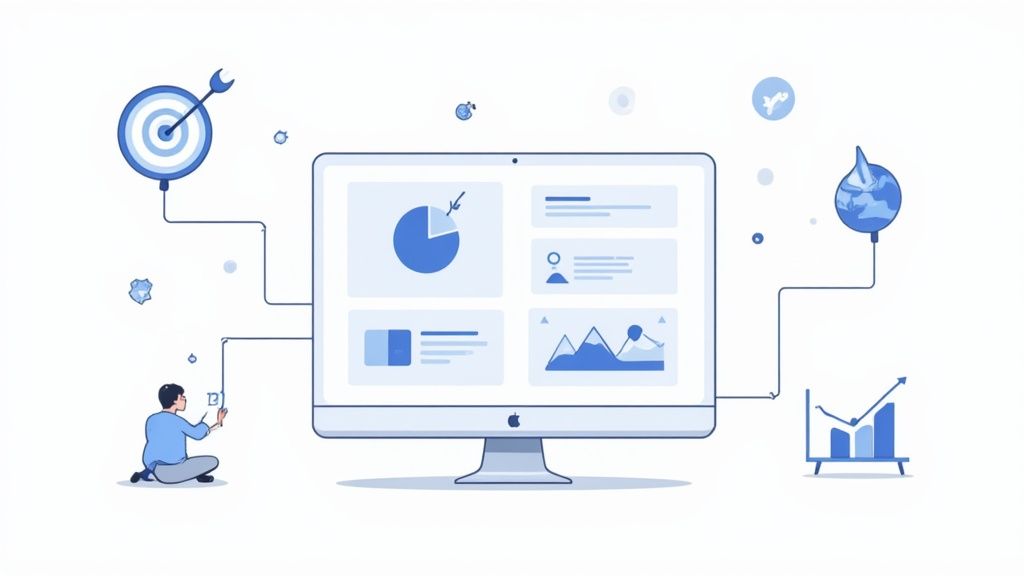Let's be frank. A performance management system should be a strategic tool. For many leaders, however, it feels more like a bureaucratic headache. It is sold as the key to aligning your people and sharpening decisions, but too often it becomes a box-ticking exercise that wastes time. That is where the whole process falls apart.
Why Your Performance Management System Is Broken

We see a familiar story with new clients. The traditional approach, built around the dreaded annual appraisal, causes more anxiety than it does growth. Managers hate how clunky it is. Employees feel like they are being judged instead of supported. It becomes a top-down chore, not what it should be: a platform for real, ongoing conversation.
This is not just a gut feeling. There is a massive trust gap in these processes across the UK and beyond. Recent research shows that a staggering 72% of workers and 61% of managers do not trust their company’s performance management processes. These systems are often expected to drive business results on their own. This is totally unrealistic when so many other factors are at play.
The real issue is the gap between the process and the people. A system that feels punishing or pointless will always fail, no matter how slick the software is.
Shifting the perspective
The fix is not about buying another platform or creating more complicated metrics. Real change starts by rethinking what performance management is actually for. It is not about policing what people do. It is about building a framework for clarity, alignment, and growth.
An effective performance management system turns a string of one-off appraisals into a continuous, strategic conversation. It links what individuals do every day to the bigger company goals. This transforms a feared admin task into something that genuinely drives focus and motivation.
When your system works, it pays you back with freed-up time and smarter decisions. It stops being about looking back to hand out ratings. It starts being about looking forward to clear roadblocks and helping people make progress.
What a better system looks like
Imagine a system where conversations happen all the time, are genuinely helpful, and focus on development. That is the heart of a modern performance management system.
It is defined by a few key changes:
- From Annual Review to Continuous Dialogue. Swapping a single, high-pressure event for regular, low-key check-ins that build trust and offer support when it is actually needed.
- From Top-Down Directives to Co-Created Goals. Getting team members involved in setting their own objectives so that they feel relevant, meaningful, and connected to the company's purpose.
- From Subjective Ratings to Shared Data. Using clear, easy-to-access data to guide conversations about progress, which makes feedback feel more objective and easier to act on.
A broken performance management system is a sign of a bigger problem. It signals a lack of clarity in how the business operates. Fixing it is not about finding the perfect template. It is about putting people first to build a more open, capable, and resilient organisation.
The Three Pillars Of A Modern Performance System
A truly effective performance management system is not just one piece of software or a rigid, top-down policy. Think of it more like a living ecosystem. It is where your people, your processes, and your technology work in harmony to create clarity and drive real growth.
When these three pillars are in balance, the system stops feeling like a box-ticking exercise. It starts becoming a genuine asset for building a more capable and resilient organisation.
As the image below illustrates, it is the interplay between goal setting, tracking, and feedback that forms the bedrock of the entire system.

This structure shows that a system is far more than the sum of its parts. It is about how they all connect to support a continuous cycle of improvement. Thinking about it this way shifts the focus from isolated, dreaded events like an annual review to an interconnected, ongoing flow of activity that actually helps people succeed.
People first: Clear and agile goals
It has to start with people. A modern approach to goals moves well beyond old-school, top-down objectives. Those get set once a year and are often irrelevant a few months later. The aim is not just to create a to-do list. It is to create genuine clarity and ownership.
This means co-creating goals with your team members, not just assigning them. When people have a hand in setting their own targets, they feel far more invested. They can clearly see how their day-to-day work connects to the bigger company picture. Frameworks like Objectives and Key Results (OKRs) can be helpful, but the specific method matters less than the conversation itself. You are aiming for objectives that are both meaningful and flexible enough to adapt when priorities inevitably shift.
Process driven: Continuous feedback loops
The second pillar is your process. Specifically, making the crucial shift from a single, high-stakes annual appraisal to a continuous feedback loop. This is where so many traditional systems fall flat. They save up all the feedback for one formal review, where it is often too little, too late.
A healthy feedback culture is built on a foundation of frequent, low-stakes conversations. These regular check-ins provide countless opportunities to remove blockers, offer support, and recognise progress in the moment. It turns managers into coaches, not just evaluators.
This simple shift builds trust and psychological safety. It creates an environment where team members feel comfortable flagging issues or asking for help. This transforms performance management from a judgemental exercise into a supportive dialogue focused squarely on development.
Technology enabled: Shared data and insight
Finally, technology should be there to support the process, not dominate it. The right tools are enablers. They automate tedious administrative tasks and provide a single, shared source of truth. This frees up everyone’s time for the meaningful conversations that actually drive performance.
Technology’s true role here is to make progress visible and data accessible to everyone. When the whole team can see how objectives are tracking, conversations become more objective and forward-looking. This is not about surveillance. It is about creating collective intelligence. Shared data helps teams make sharper, more informed decisions together.
By embedding this capability, you build a lasting digital sovereignty. This ensures your team truly owns its data and its growth long after any consultant has left the building.
Moving Beyond The Annual Appraisal

Let’s be honest. The single, high-stakes annual appraisal is one of the most dreaded rituals in business. It is a relic from another era. It crams an entire year's worth of feedback into one tense meeting. It almost never inspires genuine growth and usually creates more anxiety than clarity. So, what is the alternative?
The answer is not to simply ditch appraisals and hope for the best. It is about swapping that one massive, stressful event for a series of smaller, more valuable conversations. This is the heart of a modern performance management system. It means building a culture where feedback is a continuous, timely, and genuinely helpful part of the everyday workflow.
This shift is already well underway across the UK. More organisations realise how ineffective the old ways are. They are moving to more frequent, digitally-supported systems that slash admin, offer real-time insight, and improve how the workforce is managed. You can read more about this transition away from annual appraisals.
When you adopt a continuous model, you are not just changing a process. You are replacing a source of dread with a foundation of trust. You are creating an environment where your people feel consistently supported, not just judged once a year.
From appraiser to coach
For any of this to work, the role of the manager has to evolve. They need to transform from being a once-a-year appraiser into an ongoing, supportive coach. This is a huge shift. It demands new skills and a completely different mindset.
A coach does not just tally up past wins and losses. They help clear the path for future progress. Their main job becomes asking great questions, listening with intent, and guiding their team members towards their own solutions.
This means training your managers on how to:
- Structure purposeful check-ins. These are not just random chats. They are short, focused conversations with a clear goal, whether it is reviewing progress on key objectives or working through a specific challenge.
- Give and receive constructive feedback. This is about providing feedback that is specific, actionable, and delivered with real empathy. Crucially, it is also about creating a safe space for employees to share their own perspectives without fear.
- Focus on development. Every conversation should have a forward-looking element, touching on career aspirations and spotting opportunities for growth and learning.
Using technology the right way
Technology is a vital part of making this transition smooth. Its purpose is to support conversations, not replace them. The goal is to track progress without drowning everyone in digital paperwork.
The right platform automates the tedious administrative burden of tracking goals and feedback. This frees up precious time for the human-to-human conversations that actually drive performance and build relationships. It gives everyone a shared, visible space to see progress, making check-ins more efficient and data-driven.
This is all about fostering shared awareness, not surveillance. When technology makes dialogue easier and more transparent, it helps build a culture where everyone is aligned.
It transforms the performance management system from a rigid, top-down process into a dynamic, living tool for continuous improvement. The result? A team that feels empowered and trusted, not micromanaged.
Connecting Performance To Purpose And Motivation
A slick performance management system is useless if it does not motivate anyone. When your team cannot see how their day-to-day work connects to the bigger picture, even the most beautifully crafted goals will fall flat. The system becomes another box-ticking exercise, not a tool for inspiration.
This is where so many organisations get it wrong. They pour money into fancy platforms but miss the most crucial ingredient: the human need for purpose. Real motivation does not come from the threat of a bad review or the dangling carrot of a bonus. It is sparked by feeling that what you do actually matters.
This problem is especially bad in the UK. Recent data shows that employee motivation tied to performance recognition is trailing far behind other major economies. A shocking 60% of UK workers say they feel motivated to go the extra mile. This figure is a full 11% lower than the global average. To put that into perspective, motivation levels in the USA and India are soaring at 75% and 84% respectively. You can discover more insights into these employee motivation statistics and see just how big the issue is.
Making work meaningful
How do you fix this disconnect? The secret is to deliberately link individual performance to a shared sense of purpose. This is not about slapping a mission statement on the canteen wall. It is about making your company's core goals transparent, real, and relevant to every person on your team.
When goals are created together and tied to where the company is headed, they stop being a to-do list. They become a shared roadmap. This clarity helps every team member understand not just what they are doing, but why it is important. It reframes their work from isolated tasks into a vital piece of a larger puzzle. This is at the heart of our mission at Yopla, where we believe aligning people around a shared purpose is the foundational step to building a better business.
Challenging conventional incentives
For decades, leaders have leaned on classics like bonuses and financial rewards. While money has its place, it is a poor substitute for lasting motivation. What truly gets people fired up today is something far more personal.
When people feel seen, valued, and connected to a shared purpose, high performance becomes a natural outcome, not a forced metric. It shifts the focus from external validation to internal drive.
If you want to build this kind of environment, you need to think about what truly drives your team. It usually boils down to three things:
- Autonomy. The freedom to own their work and make their own decisions.
- Mastery. The chance to get better at what they do and develop their skills.
- Purpose. The belief that their work has a real, meaningful impact.
By building your performance management system around these core human drivers, you create a culture where people are naturally inspired to bring their best. Performance stops being something you have to police. It becomes something you can unleash.
How to Avoid Common Implementation Pitfalls

Here is a common scenario. A company treats implementing a new performance management system like a pure technology project. Leadership buys a shiny new platform, assuming it will magically fix deep-seated cultural issues. Here is the truth: without tackling the human side of change, even the most sophisticated software is destined to become expensive shelfware.
Another classic mistake is rolling out a new process without getting genuine buy-in from the managers who have to run it. If they see it as just another box-ticking exercise, they will resist, and the whole initiative will stall. Success hinges on treating this as a change management programme, not just an IT update.
By anticipating these challenges, you can design a rollout that builds momentum. The goal is to weave the new system into the fabric of your operations, making it a valued part of how you work.
Co-design with your people
The surest way to guarantee failure is to create a new system in a boardroom silo and impose it on the organisation. It is a simple human truth: people support what they help create. Involving managers and team members from the beginning is not just nice-to-have. It is non-negotiable.
This co-design approach ensures the final system is practical, relevant, and solves the real-world headaches your people face. It builds a sense of ownership and creates a network of internal champions who will advocate for the change before it even goes live.
A system designed for people will always be met with resistance. A system designed with people has a fighting chance to be embraced. This is the difference between enforcing compliance and inspiring real adoption.
Keep it simple and communicate clearly
There is a massive temptation to over-complicate things. Leaders often try to build the "perfect" system that measures absolutely everything. The result? A clunky, convoluted process that nobody understands or wants to use. Start with the absolute minimum you need to deliver value. Then iterate and improve based on real feedback.
Your communication plan is just as vital. Be radically transparent about the ‘why’ behind the change. Explain what is in it for everyone, what problems you are solving, and what the journey will look like. A clear, honest narrative helps manage expectations and calms the anxiety that comes with any change.
Successful rollouts require careful planning and a deep understanding of your culture. Our own approach to guided implementation bakes these vital steps into the process, embedding new capabilities directly within your team.
Your Next Steps To A Better Performance System
Knowing the theory is one thing. Making real, meaningful change is another game entirely. It is all about action. If you are looking to swap a broken annual review process for a modern performance management system, you need a practical roadmap. That journey does not start with picking new software. It starts with asking the right questions to figure out what is really going on inside your organisation.
First, take a hard look at where you are right now. Forget the official handbook. Talk to your managers and teams about their actual experience. Where does the current system cause friction? At what point does it stop giving people the clarity they need to excel? Getting an honest, unfiltered view of the situation is the only solid foundation to build upon.
Defining what good looks like
Once you have pinpointed the problems, you can start sketching out what a better future looks like. This is not about chasing some off-the-shelf model. It is about getting everyone on the same page and building a system that supports both your employees and your strategic goals.
To get that shared vision, bring your leadership team together and tackle these crucial questions:
- What is the main goal here? Are we focused on accountability, development, or a mix of both?
- How do we turn feedback from a high-stakes annual ordeal into a continuous, low-pressure conversation?
- What information do we actually need to have objective, forward-looking discussions about progress?
Wrestling with these questions as a team builds alignment and shared ownership from the start.
A better performance management system is not just an end goal. Think of it as a strategic lever that creates efficiency. This frees up leadership’s time to choose between driving performance, building resilience, or striking a healthy balance between the two.
At Yopla, our copilot approach is designed to guide you through this process. We help you diagnose root issues, co-design a solution that works, and embed these new ways of working directly within your team. This sharp focus on continuous improvement ensures you are not just implementing a new system, but building a more capable and resilient organisation for the long haul.
Your Performance Management Questions Answered
We get it. Changing something as core to your business as performance management always kicks up questions. Let’s tackle the big ones we hear from leaders who are ready to build a system that actually works.
How do we choose the right performance management system?
This question is not really about the platform. It is about your people and your process. Before you look at software, you need to be clear on what you are trying to fix or improve. Is the goal to spark development, create accountability, or just find a less painful way to track goals?
Get your managers and their teams in a room and ask them. A system designed with your people will always stand a better chance than one pushed on them from the top. Once you know what you need, prioritise a system that integrates with tools you already use and is flexible enough to grow with you.
How often should performance conversations happen?
It is time to kill the dreaded annual appraisal. It does not work. The best rhythm is built on frequent, low-stakes conversations. We recommend quarterly check-ins to see how things are tracking against goals and talk about development.
But that is just the baseline. Those bigger chats should be backed up by regular, informal one-to-ones. The aim is to make feedback a normal, continuous part of how you work, not a rare, high-pressure event. This is how you build trust and give people a chance to adjust course in real time.
How do we measure performance fairly?
Fairness starts with clarity. When everyone is confused about what "good" looks like, measurement becomes a guessing game. The solution is to create clear, measurable goals together using a solid framework like OKRs or SMART goals.
The real key to fairness is looking at both the ‘what’ (the results) and the ‘how’ (the behaviours and values people showed). This gives you the full story and grounds conversations in shared data, not just one person's opinion.
When you use a system that makes progress visible to everyone, you strip away the ambiguity. It helps you make sure evaluations are consistent and fair for every person in the business.
We have put together a quick summary of the most common questions we hear from leaders navigating this change.
Frequently Asked Questions
The theme is simple: put your people and your process at the centre of your thinking. You will build a system that drives real growth instead of just ticking boxes. Ready to cut through the fog and build a system that works? Let's Talk.






